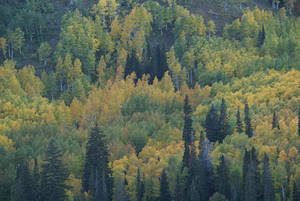The rock underneath forests can act as a previously unknown source of nitrogen...
Work published this week in the journal Nature has been unearthing whether bedrock, the rock found beneath the soil, can provide nitrogen to the trees and plants growing above it. Nitrogen is one of the four most abundant elements in living organisms and is a major component of both proteins and DNA. This means that when it is a limiting resource, a lack of nitrogen can stunt growth.
"In the past it was thought that nitrogen only came into ecosystems from the atmosphere in the form of rainwater or via specialised bacteria called Rhizobium," explains Professor Benjamin Houlton, one of the co-authors of the study. Their work, done at the University of California has shown that "there is a tremendous amount if nitrogen in [certain] rock material".
 Sedimentary rocks, which are formed from ancient organisms settling on the ocean floor and being transformed over time, contain trapped nitrogen from the organic matter. Forests growing on such rock are able to use that stored nitrogen as the rocks erode. In comparison igneous rock is not enriched in nitrogen as it is formed from the solidification of lava.
Sedimentary rocks, which are formed from ancient organisms settling on the ocean floor and being transformed over time, contain trapped nitrogen from the organic matter. Forests growing on such rock are able to use that stored nitrogen as the rocks erode. In comparison igneous rock is not enriched in nitrogen as it is formed from the solidification of lava.
By comparing two sites they were able to see stark differences in the nitrogen makeup of forests grown on sedimentary rock as opposed to on igneous rock. Detectable traces of nitrogen with the same composition as the rocks on which they were growing were found in the forests growing above the sedimentary rock, but this was lacking completely from the forests over the igneous rock. The forests located over sedimentary rock also had a nitrogen content that was more than double that of the trees growing above igneous rock. 
"It's a new discovery that nitrogen actually is in the rocks and is available to forest and other plant ecosystems" explains Professor Houlton, "With more nitrogen available they were able to grow faster and so can potentially store more carbon dioxide". This can have implications in identifying hot-spot areas on which to grow trees as part of carbon-offset schemes.
This finding is also potentially globally significant because 75% of the rock underlying the land surface is composed of sedimentary rock. This can help in refining climate change models as the amount of nitrogen available may be up to 30% greater than was previously supposed. The impact this can have on forest growth patterns has been confirmed by the team regionally, but more studies will take place to assess the global significance.
This work highlights an interesting balance. Both fossil fuels, a source of carbon dioxide, and sedimentary rock, a source of nitrogen, were formed at around the same time billions of years ago. This stored carbon is being released as we burn fossil fuels but some of it is being recaptured into trees of the current age, fertilised in part by the nitrogen in similarly ancient rocks.
Interview with Benjamin Houlton about bedrock as a source of nitrogen










Comments
Add a comment